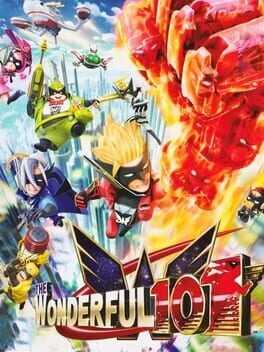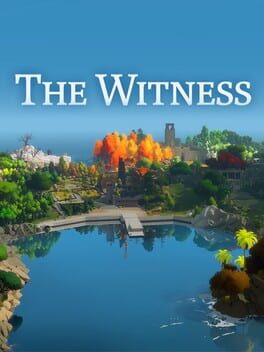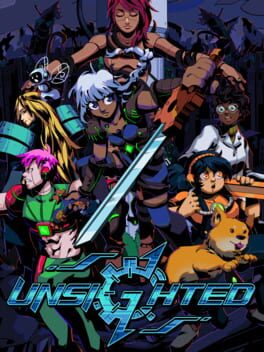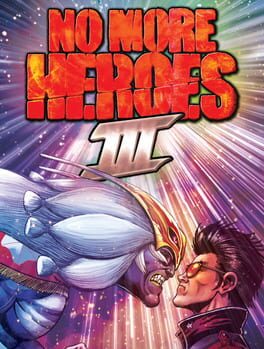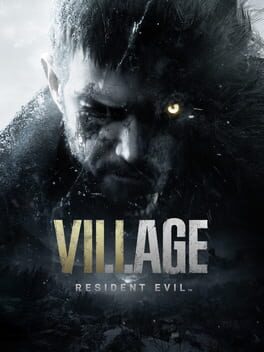Pickross
Bio
Nothing here!
Badges

Popular
Gained 15+ followers

Best Friends
Become mutual friends with at least 3 others

3 Years of Service
Being part of the Backloggd community for 3 years

Liked
Gained 10+ total review likes

Noticed
Gained 3+ followers

N00b
Played 100+ games

GOTY '20
Participated in the 2020 Game of the Year Event
Favorite Games
170
Total Games Played
000
Played in 2024
001
Games Backloggd
Recently Played See More
Recently Reviewed See More
There’s a consistent line of questioning that occurs whenever we engage with an artistic work that deviates significantly from established norms which always comes down to some form of “why”. Why was this work created like this? What benefits are there to this unconventionality? This is something that’s usually only considered when evaluating works that fail to live up to a high standard, after all with a truly great work, every choice no matter how bizarre or banal is considered to be an important part of it’s artistic identity.
I establish all this to say that for most of 13 Sentinels: Aegis Rim’s runtime, I was questioning it constantly. Why did this game, (one that establishes time travel as a narrative plot device in the first minutes) so insistent on also presenting itself as a nonlinear, chronologically inconsistent visual novel? Why are there numerous RTS roadblocks halting progression? And why oh why are there so many character introductions that amount to blips on a radar? It’s hard to pinpoint the exact spot where this messy story starts to make sense but once it does those questions began to fade into the background for a truly wonderful little game.
The rapid character introductions rapidly give way to a slew of small stories that all serve as homages to various science fiction tropes and stories, none of which are particularly overbearing in a way references can be. The formula is then to draw interest through referencing another work before the character writing and scenario begin to morph into the story the game wishes to tell. In this sense the writing remains largely consistent as my initial experience with each of the character’s scenarios was firstly understanding what media they were homaging before it becomes a much more nuanced understanding of who the character’s are and what their motivations are. In this sense the nonlinear, “choose your story” aspect of the game becomes a very effective way of maintaining someone’s interest. In the sense that a player should have some baseline familiarity with the story a character’s tale is homaging before hopefully being intrigued by one of the cameo appearances present. The most fortunate outcome for 13 Sentinels is that all the character’s stories are at least somewhat interesting or maintained by the appearance of a side character I had grown fond of.
The relationship between culture, art and the media environment born from it remains a surprisingly important theme for this story through to the very end. For something that at first glance can appear to be a mishmash of all kinds of various tropes from anime, Hollywood and sci fi novels, an consistent strength is how the characters never feel overshadowed by the world that surrounds them. Of course this means the world of the game but also the modern world of the players to a more subtle extent. Some of the best musings of the 1940s era characters have pertain to their understanding of the wartime and post-war relationship between Japan and the west. The basic fish out of water storyline of a person from 1940 seeing the 80s for the first time is tinged with far more melancholy when considering the history of Japan and the media they have created since then. This isn’t quite the anti escapism,” live in the real world” preachiness that a lot of media of this country can be guilty of but rather something that displays far more nuance about how media affects our lives. Naturally this gives way to some science fiction craziness by the story’s end but the attempt to engage critically with this stuff was largely a success.
The big detriment to having the ability to choose your own path is that sometimes critical information can be delivered way too early or implied in a way that sidesteps an important reveal. While this game does have some dependencies on story progression it didn’t stop a few handfuls of times where I was able to witness something that perhaps should’ve been saved for later. The story dependencies thankfully preserve the biggest story beats which thankfully I feel will land regardless of whatever order the player chooses. Despite this it makes me feel that there must be an ideal play order somewhere that perfectly preserves the games twists and orders them in a natural way but overall, the game was better served giving you the options to choose how you wanted to approach things.
The one question I still had lingering at the final hours was a big fat why at the RTS segments that constitute the other half of the game. These aren’t bad to be clear, but it doesn’t take that long to figure out a strategy to be prepared for virtually any situation for the first half of this segment. For the second half however, the game gets absolutely crazy with enemy formations to the point where I wasn’t really sure what other strategies, I could employ besides grinding earlier missions for experience. Not something I would recommend playing on hard. Despite this however, the game still reached a kind of catharsis for me in the final mission where the enemy forces go absolutely hog wild trying to take over your final base. The screen was so flooded that my system began to lag until one well-placed skill struck with such ferocity that I was able to retake my framerate. Pardon my language here but it was pretty kino.
For a game in which I was questioning it’s every design decision at the start, it managed to leave me with little questions at the end. Despite there being an entire narrative glossary mode to relive past events, the story still made complete sense without ever having to look at it. That’s partially why I’ve avoided speaking about any of the characters though my favorites were, Yakushiji, Gouto and Minami. One thing the marketing for this game doesn’t really tell you is that the game revels in romance and while I don’t think it was necessary for every character, one moment of Yakushiji’s story in particular was filled with enough youthful candor that it melted away the last remaining cynicism in my heart. Was a big fan of this one.
I establish all this to say that for most of 13 Sentinels: Aegis Rim’s runtime, I was questioning it constantly. Why did this game, (one that establishes time travel as a narrative plot device in the first minutes) so insistent on also presenting itself as a nonlinear, chronologically inconsistent visual novel? Why are there numerous RTS roadblocks halting progression? And why oh why are there so many character introductions that amount to blips on a radar? It’s hard to pinpoint the exact spot where this messy story starts to make sense but once it does those questions began to fade into the background for a truly wonderful little game.
The rapid character introductions rapidly give way to a slew of small stories that all serve as homages to various science fiction tropes and stories, none of which are particularly overbearing in a way references can be. The formula is then to draw interest through referencing another work before the character writing and scenario begin to morph into the story the game wishes to tell. In this sense the writing remains largely consistent as my initial experience with each of the character’s scenarios was firstly understanding what media they were homaging before it becomes a much more nuanced understanding of who the character’s are and what their motivations are. In this sense the nonlinear, “choose your story” aspect of the game becomes a very effective way of maintaining someone’s interest. In the sense that a player should have some baseline familiarity with the story a character’s tale is homaging before hopefully being intrigued by one of the cameo appearances present. The most fortunate outcome for 13 Sentinels is that all the character’s stories are at least somewhat interesting or maintained by the appearance of a side character I had grown fond of.
The relationship between culture, art and the media environment born from it remains a surprisingly important theme for this story through to the very end. For something that at first glance can appear to be a mishmash of all kinds of various tropes from anime, Hollywood and sci fi novels, an consistent strength is how the characters never feel overshadowed by the world that surrounds them. Of course this means the world of the game but also the modern world of the players to a more subtle extent. Some of the best musings of the 1940s era characters have pertain to their understanding of the wartime and post-war relationship between Japan and the west. The basic fish out of water storyline of a person from 1940 seeing the 80s for the first time is tinged with far more melancholy when considering the history of Japan and the media they have created since then. This isn’t quite the anti escapism,” live in the real world” preachiness that a lot of media of this country can be guilty of but rather something that displays far more nuance about how media affects our lives. Naturally this gives way to some science fiction craziness by the story’s end but the attempt to engage critically with this stuff was largely a success.
The big detriment to having the ability to choose your own path is that sometimes critical information can be delivered way too early or implied in a way that sidesteps an important reveal. While this game does have some dependencies on story progression it didn’t stop a few handfuls of times where I was able to witness something that perhaps should’ve been saved for later. The story dependencies thankfully preserve the biggest story beats which thankfully I feel will land regardless of whatever order the player chooses. Despite this it makes me feel that there must be an ideal play order somewhere that perfectly preserves the games twists and orders them in a natural way but overall, the game was better served giving you the options to choose how you wanted to approach things.
The one question I still had lingering at the final hours was a big fat why at the RTS segments that constitute the other half of the game. These aren’t bad to be clear, but it doesn’t take that long to figure out a strategy to be prepared for virtually any situation for the first half of this segment. For the second half however, the game gets absolutely crazy with enemy formations to the point where I wasn’t really sure what other strategies, I could employ besides grinding earlier missions for experience. Not something I would recommend playing on hard. Despite this however, the game still reached a kind of catharsis for me in the final mission where the enemy forces go absolutely hog wild trying to take over your final base. The screen was so flooded that my system began to lag until one well-placed skill struck with such ferocity that I was able to retake my framerate. Pardon my language here but it was pretty kino.
For a game in which I was questioning it’s every design decision at the start, it managed to leave me with little questions at the end. Despite there being an entire narrative glossary mode to relive past events, the story still made complete sense without ever having to look at it. That’s partially why I’ve avoided speaking about any of the characters though my favorites were, Yakushiji, Gouto and Minami. One thing the marketing for this game doesn’t really tell you is that the game revels in romance and while I don’t think it was necessary for every character, one moment of Yakushiji’s story in particular was filled with enough youthful candor that it melted away the last remaining cynicism in my heart. Was a big fan of this one.
Perhaps one of my most anticipated titles in some time, No More Heroes 3 brings the return of Suda51 into the director’s chair for a full-on return of the No More Heroes brand. Despite all the gusto behind it, it’s hard to feel that this game is a return especially with the spin-off Travis Strikes Again functioning more as a return both tonally and aesthetically to something akin to Grasshopper’s earlier projects. What we have with No More Heroes 3 is a transitory title bringing together elements of their pre and post 2010 works into a pastiche that seems to signal the direction that their company will take in the future. It is a shame then, that this one limps rather than strides towards its goal.
Nostalgia is the core of this No More Heroes experience; Travis returns with his beam katana to slice and dice his way to the top of assassination rankings. But it’s not just nostalgic for the previous No More Heroes games, NMH3 also displays an irreverent love for all things pop culture with Rocky, Takashi Miike, the MCU, Ultraman and more all being referenced in some capacity throughout the game. If you are not in tune with most of these references, as I was, then the game can come off as shallow and pandering. Any part of this game that could feel like part of some sort of satire inevitably ends up being excruciatingly shallow. There truly could’ve been something interesting to say about how voyeuristic the game is, with a Netflix style opening and closing credits and all conversations on the overworld being framed as livestreams. Despite this, it never tries hard to say anything meaningful despite all the conceptually interesting ideas the game attempts. Honestly it really does feel like this game was made for the one-person, likely Suda, who would pick up on all these references, but it doesn’t lend the game any substantive narrative or thematic weight.
With the premise being Travis versus Aliens, the stakes have been overblown to such a point that the characters can do naught but crack jokes and revel in absurdism. It really misses the mark on following up the more morose and offbeat satire that the first game and parts of Travis Strikes Again utilized. This isn’t necessarily a surprise since the tone of No More Heroes has been shifting steadily since it’s second entry, even the first one would frequently alter the character of Travis in between scenes, but it’s especially jarring to realize that this overly quirky meta ‘video games amiright?’ humor must’ve always been the intentional design of this series rather than the more grounded tone that fans of No More Heroes 1 fell in love with. And that is perhaps the most bitter pill to swallow with No More Heroes 3, that the series has transitioned from a smart parody to an overindulgent tribute.
The writing seems like the clearest division between this game and the others wherein Travis and many of his supporting characters are all written to be as one note and Flanderized as possible. I have to think this was an intentional choice since the writing of Travis Strikes Again was so laser focused on describing Travis’ thoughts with much more specificity than is attributed to a typical video game character that it is hard to not see this games version of Travis be by far the most shallow version of himself. He’s characterized as if his traits were listed by someone with only a cursory knowledge of the No More Heroes series. Sylvia also finds herself a victim of this writing style with all of her charisma and cunning being noticeably absent and replaced with a much more flat personality. No longer did I look forward to the pre fight phone calls that she would have with Travis and to a larger extent, I no longer really looked forward to Travis’ interactions with anyone. Most other returning characters are quickly tossed to the wayside whilst the aliens Travis fights range from mildly interesting to complete non characters. Numerous pieces will be written down the line on the intentionality of this deliberate “un-writing” of the characters and maybe they will even justify it, but the game is left hollow without any strong characters to stand on.
Gameplay fares a little better with this being the first mainline No More Heroes game with distinctive enemy designs that necessitate more than just relentless offense. It’s a shame that there are no themed levels with interesting designs to make the most of this rogue’s gallery cause the same copy paste arenas don’t really offer much variation in the actual fights. In addition, it’s clear that this game wasn’t designed with its higher difficulties in mind since the battles can quickly devolve into launching into 60 hit combos to take out even the simplest goon due to the radical increase in health and damage. Despite this, it was ultimately rewarding to fully understand the nuances of this combat system through playing on spicy and I truly think it is by and large the best way to play the game.
The game falters in other areas however, namely the structure. The return to No More Heroes 1’s pace of ranked assassination in between periods of mundanity seems awfully short sighted this time around. Not only does it not make sense to be going around doing part time jobs while the world faces impending alien annihilation but the clear delineation between ‘work’ and ‘play’ that the original game drew is no longer apparent. What also doesn’t help is the barren open world with only two distinct npcs populating the multiple maps. In the decade since No More Heroes, developers have been innovating newer and different ways to make open worlds even shittier and No More Heroes 3 wholeheartedly agrees with them.
With a largely shallow narrative and a subpar gameplay experience it can be assumed that this game is a failure but despite this I think that this game has enough heart and soul to redeem it slightly in my eyes. Grasshopper’s UI design continues to be some of the best in the medium and the numerous times the game goes onto mixed media non sequiturs are truly some of the most entertaining parts of this uneven experience. I hope that Grasshopper continue to push the mixed media aspects of their project more since it begins to shine as the most distinctive aspects of their works from the 2010s onwards. Unfortunately, I can’t say I look forward to future Grasshopper storytelling as it’s clear they no longer have same eclectic and nuanced substance that I fell in love with years ago. Farewell Travis Touchdown, enjoy your retirement.
Nostalgia is the core of this No More Heroes experience; Travis returns with his beam katana to slice and dice his way to the top of assassination rankings. But it’s not just nostalgic for the previous No More Heroes games, NMH3 also displays an irreverent love for all things pop culture with Rocky, Takashi Miike, the MCU, Ultraman and more all being referenced in some capacity throughout the game. If you are not in tune with most of these references, as I was, then the game can come off as shallow and pandering. Any part of this game that could feel like part of some sort of satire inevitably ends up being excruciatingly shallow. There truly could’ve been something interesting to say about how voyeuristic the game is, with a Netflix style opening and closing credits and all conversations on the overworld being framed as livestreams. Despite this, it never tries hard to say anything meaningful despite all the conceptually interesting ideas the game attempts. Honestly it really does feel like this game was made for the one-person, likely Suda, who would pick up on all these references, but it doesn’t lend the game any substantive narrative or thematic weight.
With the premise being Travis versus Aliens, the stakes have been overblown to such a point that the characters can do naught but crack jokes and revel in absurdism. It really misses the mark on following up the more morose and offbeat satire that the first game and parts of Travis Strikes Again utilized. This isn’t necessarily a surprise since the tone of No More Heroes has been shifting steadily since it’s second entry, even the first one would frequently alter the character of Travis in between scenes, but it’s especially jarring to realize that this overly quirky meta ‘video games amiright?’ humor must’ve always been the intentional design of this series rather than the more grounded tone that fans of No More Heroes 1 fell in love with. And that is perhaps the most bitter pill to swallow with No More Heroes 3, that the series has transitioned from a smart parody to an overindulgent tribute.
The writing seems like the clearest division between this game and the others wherein Travis and many of his supporting characters are all written to be as one note and Flanderized as possible. I have to think this was an intentional choice since the writing of Travis Strikes Again was so laser focused on describing Travis’ thoughts with much more specificity than is attributed to a typical video game character that it is hard to not see this games version of Travis be by far the most shallow version of himself. He’s characterized as if his traits were listed by someone with only a cursory knowledge of the No More Heroes series. Sylvia also finds herself a victim of this writing style with all of her charisma and cunning being noticeably absent and replaced with a much more flat personality. No longer did I look forward to the pre fight phone calls that she would have with Travis and to a larger extent, I no longer really looked forward to Travis’ interactions with anyone. Most other returning characters are quickly tossed to the wayside whilst the aliens Travis fights range from mildly interesting to complete non characters. Numerous pieces will be written down the line on the intentionality of this deliberate “un-writing” of the characters and maybe they will even justify it, but the game is left hollow without any strong characters to stand on.
Gameplay fares a little better with this being the first mainline No More Heroes game with distinctive enemy designs that necessitate more than just relentless offense. It’s a shame that there are no themed levels with interesting designs to make the most of this rogue’s gallery cause the same copy paste arenas don’t really offer much variation in the actual fights. In addition, it’s clear that this game wasn’t designed with its higher difficulties in mind since the battles can quickly devolve into launching into 60 hit combos to take out even the simplest goon due to the radical increase in health and damage. Despite this, it was ultimately rewarding to fully understand the nuances of this combat system through playing on spicy and I truly think it is by and large the best way to play the game.
The game falters in other areas however, namely the structure. The return to No More Heroes 1’s pace of ranked assassination in between periods of mundanity seems awfully short sighted this time around. Not only does it not make sense to be going around doing part time jobs while the world faces impending alien annihilation but the clear delineation between ‘work’ and ‘play’ that the original game drew is no longer apparent. What also doesn’t help is the barren open world with only two distinct npcs populating the multiple maps. In the decade since No More Heroes, developers have been innovating newer and different ways to make open worlds even shittier and No More Heroes 3 wholeheartedly agrees with them.
With a largely shallow narrative and a subpar gameplay experience it can be assumed that this game is a failure but despite this I think that this game has enough heart and soul to redeem it slightly in my eyes. Grasshopper’s UI design continues to be some of the best in the medium and the numerous times the game goes onto mixed media non sequiturs are truly some of the most entertaining parts of this uneven experience. I hope that Grasshopper continue to push the mixed media aspects of their project more since it begins to shine as the most distinctive aspects of their works from the 2010s onwards. Unfortunately, I can’t say I look forward to future Grasshopper storytelling as it’s clear they no longer have same eclectic and nuanced substance that I fell in love with years ago. Farewell Travis Touchdown, enjoy your retirement.
The most brilliant innovation of Unsighted’s design is the process of becoming unsighted itself. Every character is an automaton with a fixed amount of hours remaining before they regress into a hostile overworld enemy. Your goal is to save them from their fates but it’s made difficult since the resource to save them is so scarce. On the surface, a pretty interesting premise to play around with but it falls short in a few key areas.
Namely, the way in which it’s introduced. This tidbit is dropped rather unceremoniously after the prologue and the fear that every life, including your own, is doomed to end drives a forward progression in the player to speedrun the game. However the game loses that all important emotional connection that it espouses in it’s story and generally in what this kind of mechanic seems built for when the player is encouraged to run as far as possible away from your allies and thrust themselves into the dungeons. An alternative proposal would’ve been to secret away the knowledge that every character operates on a timer, and instead reveal that information after some time has been spent to foster a connection. With the game’s multitude of flashback scenes detailing what happened before the unsighted crisis, I think making them playable would’ve gone a long way in harmonizing both gameplay mechanics and themes.
This is especially egregious considering the conditions of the “true” ending. Naturally one may expect this to be the path where no one dies. Instead of needing a speedrun, the game requires the player to essentially get an item that allows them to rewind time to the start with all their items and then confront the final boss. It’s ridiculous that this was included since it appears to be totally possible to beat the game in under an hour(evidenced by the achievement screen). I understand this was probably done to ensure that anyone could get the ending on their first try but I truly wish they pushed against the player harder with this particular mechanic considering so many aspects of it feel like an afterthought and that is one thing such an interesting idea shouldn’t be.
As far as the actual gameplay is concerned, despite being advertised as a kind of metroidvania, Unsighted is in reality more of an iteration on something like A Link to the Past. The influence was obvious in how they highlight all the major dungeons with the exact same design as that of the dark world dungeons in that game. However the player is given a huge amount of freedom in how they choose to approach any of the dungeons since they can be entered at any time and items can be got out of sequence. I didn’t experiment with this much as of writing but I did find it interesting that all items including the dungeon specific puzzle items can be crafted immediately and their blueprints can be found relatively easily. I’m usually the first to scoff at unnecessary survival mechanics in games but this served as a good compromise, really allowing the player to make the world their own.
Unfortunately the puzzles don’t approach a similar level of complexity to A Link to the Past and I suppose making the dungeons relatively breezy was to serve the time limit. The level design can be surprisingly readable almost too readable at some points but the combat is a different story. Some endgame bosses can have such an overwhelming amount of things to keep track of on screen and it becomes clear that the only way to deal a reasonable amount of damage against the higher level enemies is to parry constantly. Parrying is also incentivized since it refills your stamina completely and gives you brief invulnerability. This later game bosses can turn into exercises in parry fishing which never feels great. Thankfully the game is short enough that these minor annoyances don’t amount to much and only feel noticeable at the end game when the health bars get massive.
Perhaps Unsighted’s most brilliant contribution is the sheer vibe. Running around this primitive cyberpunk world, listening to a dark jazzy piano hum gently in the rain is such a comfy feeling. I wish there was more to this game then there ultimately was, but it is a project where I could feel a lot of attention and soul flowing out of the screen. Despite my problems with the game not being able to get you attached to any of the characters, I smiled when the main character saves the girl and the epilogue shows all the citizens you saved, or chose not to, living peacefully with one another. A little sappy, a little too melodramatic but a passionate and sweet little game.
Namely, the way in which it’s introduced. This tidbit is dropped rather unceremoniously after the prologue and the fear that every life, including your own, is doomed to end drives a forward progression in the player to speedrun the game. However the game loses that all important emotional connection that it espouses in it’s story and generally in what this kind of mechanic seems built for when the player is encouraged to run as far as possible away from your allies and thrust themselves into the dungeons. An alternative proposal would’ve been to secret away the knowledge that every character operates on a timer, and instead reveal that information after some time has been spent to foster a connection. With the game’s multitude of flashback scenes detailing what happened before the unsighted crisis, I think making them playable would’ve gone a long way in harmonizing both gameplay mechanics and themes.
This is especially egregious considering the conditions of the “true” ending. Naturally one may expect this to be the path where no one dies. Instead of needing a speedrun, the game requires the player to essentially get an item that allows them to rewind time to the start with all their items and then confront the final boss. It’s ridiculous that this was included since it appears to be totally possible to beat the game in under an hour(evidenced by the achievement screen). I understand this was probably done to ensure that anyone could get the ending on their first try but I truly wish they pushed against the player harder with this particular mechanic considering so many aspects of it feel like an afterthought and that is one thing such an interesting idea shouldn’t be.
As far as the actual gameplay is concerned, despite being advertised as a kind of metroidvania, Unsighted is in reality more of an iteration on something like A Link to the Past. The influence was obvious in how they highlight all the major dungeons with the exact same design as that of the dark world dungeons in that game. However the player is given a huge amount of freedom in how they choose to approach any of the dungeons since they can be entered at any time and items can be got out of sequence. I didn’t experiment with this much as of writing but I did find it interesting that all items including the dungeon specific puzzle items can be crafted immediately and their blueprints can be found relatively easily. I’m usually the first to scoff at unnecessary survival mechanics in games but this served as a good compromise, really allowing the player to make the world their own.
Unfortunately the puzzles don’t approach a similar level of complexity to A Link to the Past and I suppose making the dungeons relatively breezy was to serve the time limit. The level design can be surprisingly readable almost too readable at some points but the combat is a different story. Some endgame bosses can have such an overwhelming amount of things to keep track of on screen and it becomes clear that the only way to deal a reasonable amount of damage against the higher level enemies is to parry constantly. Parrying is also incentivized since it refills your stamina completely and gives you brief invulnerability. This later game bosses can turn into exercises in parry fishing which never feels great. Thankfully the game is short enough that these minor annoyances don’t amount to much and only feel noticeable at the end game when the health bars get massive.
Perhaps Unsighted’s most brilliant contribution is the sheer vibe. Running around this primitive cyberpunk world, listening to a dark jazzy piano hum gently in the rain is such a comfy feeling. I wish there was more to this game then there ultimately was, but it is a project where I could feel a lot of attention and soul flowing out of the screen. Despite my problems with the game not being able to get you attached to any of the characters, I smiled when the main character saves the girl and the epilogue shows all the citizens you saved, or chose not to, living peacefully with one another. A little sappy, a little too melodramatic but a passionate and sweet little game.


